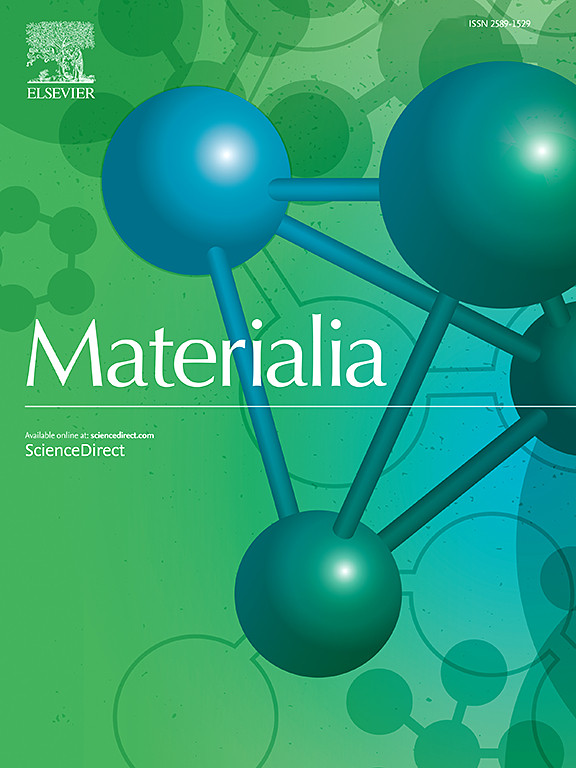Significantly improving the degradation performance of low-alloyed Mg-1Zn-0.3Ca-1.0MgO composite in vitro and in vivo
IF 3
Q2 MATERIALS SCIENCE, MULTIDISCIPLINARY
引用次数: 0
Abstract
The in vitro and in vivo degradation behavior of a low-alloyed Mg-1Zn-0.3Ca-1.0MgO (wt.%) composite with different grain sizes were investigated to understand the effect of high-density grain boundaries (GBs) and high-volume-fraction second phases on its degradation behavior. The results indicated that the ultra-fine-grained (UFG, 0.5 μm) composite had plentiful nano-sized Ca2Mg6Zn3 phase, while coarse grained (CG, 8 μm) composite possessed very few minor Ca2Mg6Zn3 phases due to the high solid solubility of solute atoms in Mg matrix. The immersion test in simulated body fluids (SBF) suggested the UFG composite had a low corrosion rate of 0.68 mm/y, which was only half of the CG composite (1.39 mm/y). This improved corrosion resistance was attributed to the quick formation of a compact and stable corrosion product, resulting from the preferential corrosion of uniformly distributed GBs and second phases in the UFG matrix during the early stage (first 12 hours). This can shield the Mg matrix from further corrosion over the long term. The in vivo implantation results after 24 weeks also showed that the corrosion rate of UFG composite was extremely low at 0.047 mm/y, while it was 0.252 mm/y for CG composite. Such higher corrosion resistance of UFG promoted luxuriant new bone growth and a more tightly bonded interface between the bone and the sample. The matched material degradation-bone maturation rate of UFG provided a better environment for osteoblast attachment and differentiation. Furthermore, the UFG composite maintained approximately 50 % residual yield strength even after 24 weeks post-implantation, which provided excellent mechanical support during service, especially in the first three months post-implantation. These results provide insights into the composition and microstructural design, which could be a promising avenue for exploring the manufacturing of high strength and highly corrosion resistant magnesium-based materials to enhance the security as bone implant instruments.

显著提高了低合金Mg-1Zn-0.3Ca-1.0MgO复合材料的体外和体内降解性能
研究了不同晶粒尺寸低合金Mg-1Zn-0.3Ca-1.0MgO (wt.%)复合材料的体内外降解行为,以了解高密度晶界(GBs)和高体积分数第二相对其降解行为的影响。结果表明:超细晶(UFG, 0.5 μm)复合材料具有丰富的纳米Ca2Mg6Zn3相,而粗晶(CG, 8 μm)复合材料由于溶质原子在Mg基体中的高固溶性,具有少量的纳米Ca2Mg6Zn3相。模拟体液(SBF)浸泡试验表明,UFG复合材料的腐蚀速率较低,为0.68 mm/y,仅为CG复合材料(1.39 mm/y)的一半。这种提高的耐腐蚀性归因于快速形成致密稳定的腐蚀产物,这是由于在早期(前12小时)均匀分布的gb和UFG基体中的第二相优先腐蚀造成的。这可以长期保护Mg基体免受进一步的腐蚀。24周后的体内植入结果也显示,UFG复合材料的腐蚀速率极低,为0.047 mm/y,而CG复合材料的腐蚀速率为0.252 mm/y。UFG具有较高的耐腐蚀性,促进了新骨的繁茂生长,并使骨与样品之间的界面结合更加紧密。UFG匹配的材料降解-骨成熟率为成骨细胞附着和分化提供了更好的环境。此外,即使在植入24周后,UFG复合材料仍保持约50%的残余屈服强度,这在使用期间提供了出色的机械支持,特别是在植入后的前三个月。这些结果为镁基材料的组成和显微结构设计提供了新的见解,为探索高强度、高耐腐蚀镁基材料的制造提供了一条有希望的途径,以提高作为骨植入器械的安全性。
本文章由计算机程序翻译,如有差异,请以英文原文为准。
求助全文
约1分钟内获得全文
求助全文
来源期刊

Materialia
MATERIALS SCIENCE, MULTIDISCIPLINARY-
CiteScore
6.40
自引率
2.90%
发文量
345
审稿时长
36 days
期刊介绍:
Materialia is a multidisciplinary journal of materials science and engineering that publishes original peer-reviewed research articles. Articles in Materialia advance the understanding of the relationship between processing, structure, property, and function of materials.
Materialia publishes full-length research articles, review articles, and letters (short communications). In addition to receiving direct submissions, Materialia also accepts transfers from Acta Materialia, Inc. partner journals. Materialia offers authors the choice to publish on an open access model (with author fee), or on a subscription model (with no author fee).
 求助内容:
求助内容: 应助结果提醒方式:
应助结果提醒方式:


